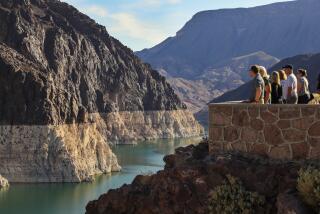Water pressure
- Share via
Even a commodity as basic as water is an uncertain thing in Southern California. With a current drought in the Colorado River basin, the prospect of drier years ahead caused by global warming, squabbles over water contracts and a recent court ruling that threatens to cut supplies from the Sacramento-San Joaquin River Delta by up to 30%, these are times for serious concern about keeping the region’s needs quenched.
A forward-thinking water district in Riverside County is the first major agency to make that abstract concern concrete, by putting construction projects on hold because of tight water supplies. Its decision outlines clearly how dire the choices are, and how much more painful they will become, if land and water planners don’t work together on major conservation projects.
Water agencies have played a dangerous game since 2001, when new state laws required them to determine that there would be enough water for 20 years to serve large new developments before approval could be granted. As dependent as this semi-arid area is on imported water, they gambled that the water would keep flowing. That is, until the Eastern Municipal Water District gave the region a much-needed reality check. Its planners studied the numbers and the forecasts and said: Sorry, the water isn’t there. The brakes were put on several new projects, including a giant Skechers USA warehouse near Lake Perris.
Continued regional sprawl is unwise for many reasons besides water: traffic, energy, pollution, environmental degradation. But no one should want to see a major new source of jobs stopped simply because we can’t get the taps turned on.
David J. Slawson, president of the water district’s board, said he’s surprised that other districts haven’t come to similar conclusions. It seems inevitable that they’ll have to, and soon. The governor and Republican lawmakers cite the continued pressure on water supplies as a reason to build more dams and storage. A better first step toward securing California’s water supplies would be to promote conservation and reuse programs, and to urge planners to get real about this finite resource. As the Eastern Municipal Water District seems to understand, developers and planners alike must come up with creative ways to keep our state growing without sucking it dry.
More agencies should be following the example of the Orange County Water District, which built a plant to reclaim sewage and turn it into clean drinking water. An area this dry might need appropriate landscaping zoned into existence. And water rates should be adjusted more sharply, so that once basic household needs are met, the price rises steeply enough to discourage waste. The decisions could get this simple: Would we rather have lawns or jobs?
More to Read
Sign up for Essential California
The most important California stories and recommendations in your inbox every morning.
You may occasionally receive promotional content from the Los Angeles Times.













